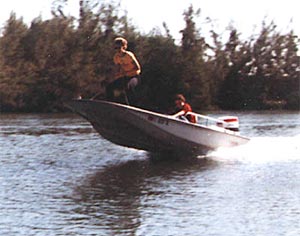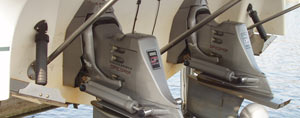Power Tilt and Trim for Outboard Engines Above 30hp
 A passenger leaping up and down in the bow can affect the boat's trim and performance.
A passenger leaping up and down in the bow can affect the boat's trim and performance.Outboard engines above about 30 hp are generally equipped with power tilt and trim. There are usually two hydraulic pistons set into the engine bracket, the "trim" part of the system, used to adjust the angle of the engine when under power. There is also a single hydraulic rod connected higher on the engine, the "tilt" part of the system, which is used to tilt it up clear of the water. In shallow water, tilting up into this higher range for slow speed operations is OK.
Trim Angle Depends on Boat Speed and Water and Weather Conditions
The proper trim angle for outboard engines depends on the speed and the conditions. Trimming the engine will adjust the angle at which the boat rides through the water. In smooth water, a GPS makes finding the best angle easy. Just trim the engine all the way down, set the power to your normal cruise setting, and start trimming up slowly in small increments. The speed will increase as the hull finds the most efficient trim angle, and when you have gone too far, it will start to decrease again. Other bad things may happen when you go to far, such as excessive cavitation, porpoising, or your friend jumping up and down on the bow.
Boats with V Hulls May Ride Better With a Little More Trim
I have found that many V-hull boats ride better in choppy water with the engine trimmed in a bit from the most efficient angle. With the engine trimmed in, the hull rides flatter over the water, and it breaks through the water further forward, where the hull has a sharper deadrise angle. Also, if the bow of the boat bounces up and down a bit, it doesn't affect passengers sitting further back as much as if the center of the boat bounces up and down on the same chop.
When riding across the wind in a chop, you are likely to get wet, especially if you are on the upwind side of the boat. You can usually get a more dry, comfortable ride by trimming the engine above the optimal angle. The bow of the boat rides very high, and the spray is thrown behind you. It will be a more bouncy ride than with the engine trimmed further in, but at least you'll be dry.
On boats equipped with hydraulic trim tabs, you have the additional option of trimming the engine to the optimal angle and then using the trim tabs to lower the downwind side of the boat and raise the upwind side.
When riding downwind in a chop, I like to keep the engine trimmed out enough to keep the bow pretty high. You never know when one of those waves is going to be a bit bigger than it looked, and if you're keeping the bow of the boat down, you might just dive right through.
Best Trim in Larger Waves
In large waves, the same general rules apply as with driving a boat in chop, except that you need to be cautious. The best plan is, just don't drive fast if the waves get large. I don't find it fun, and it's hard on the equipment. It is also a good way to drive a boat through a wave when going upwind or downwind, and a good way to capsize going across the wind.
In large waves, I want the boat to be controllable, and I want it to plane at slow speeds. For both those reasons, it is best to trim the engine down far enough to help keep the boat level and on plane at slower speeds. In some cases, that might mean all the way down past vertical.
Hydraulic Systems Require Little Maintenance
Hydraulic tilt and trim systems are very low maintenance items. There are switches, hydraulic pressure pump and lines, cylinders, shafts, seals and valves, and any of them can fail or be broken, but if you keep them clean and use them once a month or more, they can last for years. When trailering a boat, be sure to lock the engine in the tilted position with the manufacturer's lock or some other mechanical lock. Bouncing down the road is hard on the hydraulic seals, and the way the engine can bounce up and down if not properly restrained can also stress the transom of the boat.
 Trim tabs should not be confused with a trim tab. Trim tabs are mounted on the hull to control the attitude of the boat. Above, you can see the boat's trim tabs on either side of the engines.
Trim tabs should not be confused with a trim tab. Trim tabs are mounted on the hull to control the attitude of the boat. Above, you can see the boat's trim tabs on either side of the engines.
One last note for anyone who is still trying to figure out all the terms used. Although this page is about hydraulic power tilt and trim systems on outboard engines, I also mentioned hydraulic trim tabs, which are a completely separate piece of equipment. They are hinged plates mounted on the bottom of the transom of a boat, with hydraulic pistons to move them up and down. They can push the bow of the boat down on either side by deflecting water downward on the opposite side.
A Word About the Words:
Trim, Trim Tabs, and Trim Tab
In addition to hydraulic trim tabs on boats, outboard engines also have a device called a trim tab. It is a small "winglet" mounted on the bottom of the anti-cavitation plate just aft of the propeller, and the purpose is to counteract propeller torque in the steering. It is usually set once for the boat, and that's it.
On some engines, the trim tab is made of zinc, which is a way to get people to change the sacrificial zinc anode now and then in environments where that is important.
So, "trim" is the lower range of engine tilt, "trim tabs" are hull-mounted devices to control boat attitude, and a "trim tab" is also an anti-torque device on an engine.
Leave a Reply
You must be logged in to post a comment.